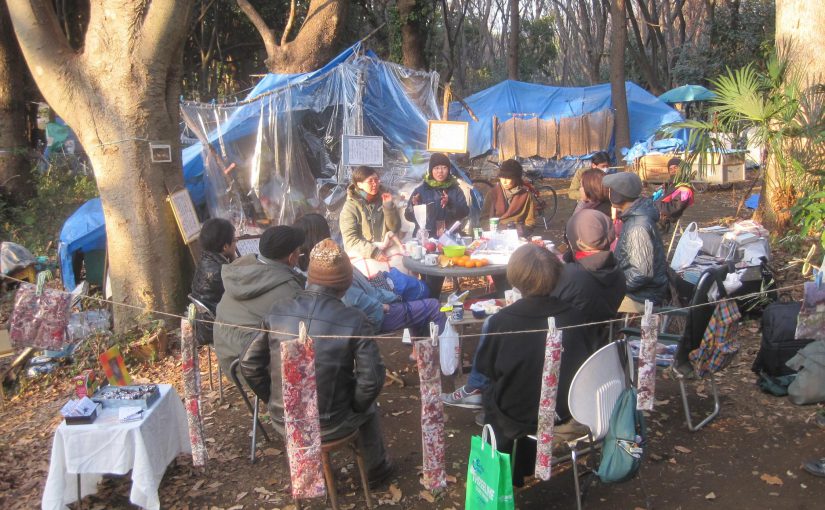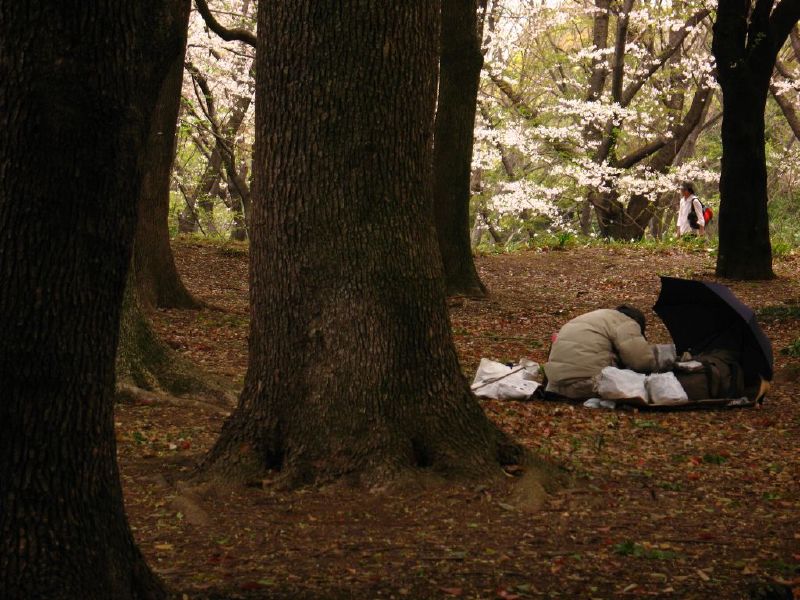We spoke to long-time organizer and artist Misako Ichimura on squatting and homelessness in Japan’s public parks and city spaces. Misako has for decades worked to try and build community and safe spaces for Japan’s unhoused community.
I hope our conversation (translated by Nami Nanami) helps readers understand that even in Japan, homelessness is an issue that profoundly impacts society.
Asia Art Tours: From reading about your background, you squatted in Amsterdam before starting the Blue Tent project in Tokyo. Could you discuss your own journey with homelessness? And how did your views on ‘capitalism’ or ‘private property’ change from your time being homeless?
Misako Ichimura: Since 2003, I’m living in a park in Tokyo. Before that, I’ve been living on streets pitching a tent or I traveled from place to place. For me, it was an art project of drawing. The streets became my canvas, and I didn’t want to become separated from lively hustle and bustle I was surrounded with every day. At that point, I was highly skeptical towards the whole idea of expensive rent, and being forced into wage labor in order to be able to bay it. Something I never want to do. The whole rat race called labor market and all things that were being promoted were, for me, nothing that was desirable. And being forced to join this race was a real pain. Looking for a way to combine my artistic expression and my daily life, then I came across this tent village where almost 350 people lived back then. The people who lived there collected junk from the streets, build their own houses, and had a community where money didn’t take a big role.
All of this happened in the middle of Tokyo, this business-centered city. It seemed so creative and I felt that also I could be living there. We are living connected to each other, sharing things or knowledges. Although we need small amount of money sometimes, often networks and communities of mutual aid mean more than maximizing private property. The squat culture I experienced in Amsterdam in 2002 likely had some impact on my values regarding housing and designing everyday life the way I’m doing is, which is also I learned from my experience of art production. In the EU, squatting was not rare at all for students and young artists back then. It was heralded as a right to the city, living in the heart of it and thus, as a resident, opposing gentrification.
 Community gathering at the unhoused ‘Blue Tent’ Village of Tokyo inside Yoyogi Park. Photo Credit: THE VISIBLE PROJECT
Community gathering at the unhoused ‘Blue Tent’ Village of Tokyo inside Yoyogi Park. Photo Credit: THE VISIBLE PROJECT
Asia Art Tours: How is ‘homelessness’ discussed in Japanese Media or by the Japanese Public? And what are some of the everyday challenges the homeless have to deal with to survive in Tokyo?
Misako Ichimura: Local governments and media picture “homeless“ people as a stigma to a city’s image, as persons who should not be there. And since the local government doesn’t see homeless people as local residents, it doesn’t hold back the pressure to kick them out or exclude them. Such an attitude influences the people in a way that it can lead up to attacks on the homeless. It is the biggest challenge for us living as homeless to resist against this eviction and exclusion. When we experienced violence and exclusion, maintaining self-care and mutual care in our community also become tough.
 An unhoused man displaced by Hanami (Cherry Blossom) Parties inside Yoyogi Park. Photo Credit: Glen Malley- FLICKR
An unhoused man displaced by Hanami (Cherry Blossom) Parties inside Yoyogi Park. Photo Credit: Glen Malley- FLICKR
Asia Art Tours: How do people ‘become’ Homeless in Japan? And once homeless, how do they again find / gain access to housing?
Misako Ichimura: Every person has their own unique story of becoming homeless. Some were provided housing by their employers but got fired and thus lost their home, so in the end they become homeless. Some got by as day laborers, but gradually jobs became less ans less, which led to not being able to pay rent, so in the end they had to leave their home. Also, there are people who experienced domestic violence, which was the reason they had to leave their home and end up on the street. Although you can rely on welfare money or social support program for homeless people’s financial independence, social worker of the local government can find your family or relatives by using public database and ask them if they can financially take care of you. This is relic of ‘traditional’ Japanese Family System(‘ie’-system) which remains even after the WW2 ends.
 The closure and reallocation of parks in Tokyo for the Olympics, has led to numerous unhoused citizens being forcibly removed or relocated. Above is a picture of the closure of Meiji Park. Photo Credit: KNOCK -LA
The closure and reallocation of parks in Tokyo for the Olympics, has led to numerous unhoused citizens being forcibly removed or relocated. Above is a picture of the closure of Meiji Park. Photo Credit: KNOCK -LA
Asia Art Tours: I know you have been speaking out recently on the Tokyo Olympics. Could you discuss how the Olympics will harm Japan’s Homeless Population? And how has Japan supported the homeless during the Covid-19 crisis?
Misako Ichimura: Even now, though Tokyo Olympics may not be held, pressure towards homeless people for eviction from public space is getting harsher. There are almost zero governmental support specifically for homeless people under the COVID-19 crisis. System of life security and Special Cash COVID-19-payments, which should be accessible for every single person, are not designed for people who have no housing. They don’t accept your address registration, which is needed to receive these supports, if you sleep on street. Besides, the slogan “Stay Home” means nothing to us in terms of infection prevention.
Asia Art Tours: I think many younger ‘leftists’ avoid working with the homeless. Could you explain if you think it’s important to work with, develop mutual aid with, and ‘organize’ with homeless people?
Misako Ichimura: With the decrease of the number of homeless people, the number of their supporters is declining as well. However, activists and volunteers hold community soup kitchens together with homeless people. In a way of ‘traditional’ homeless support, we are separated between support givers and support takers. To eliminate this hierarchical structure, on the other hand, we take a community kitchen-style-approach called ‘kyodo suiji’, where supporters and homeless prepare and eat the food together. While living as homeless persons, we experience different incidents. Eviction attempts by the local government, harassments by the police, as well as conflicts and mutual care amongst ourselves. Sometimes we need a couple of years to solve them. As we have practiced so far, we the homeless believe it is important to help each other and to organize a movement for resistance against evictions.
 Art from the Blue Tent Village. Photo Credit – THE VISIBLE PROJECT
Art from the Blue Tent Village. Photo Credit – THE VISIBLE PROJECT
Asia Art Tours: To conclude, could you tell us more about your Blue Tent Project? And are their similar efforts throughout Japan to support the Homeless?
Misako Ichimura: I’m living connected with other homeless people on the streets , mainly with those in the park where I live since 2003. My activity is not limited to my tent village. I collaborate with people in other cities or even with some people who do have a roof above their head, but don’t fit into the idea of patriarchal ‘home’ and thus are having troubles. Besides that, I sometimes become a part of some major life event of the people I live with. These events may be personal, but they occur in relation to the social condition or the pressure it puts on the people. It is very difficult to tell the history of this place. Obviously, the difference between what is recorded and what is not recorded is not the difference between what is important and what is not.
However, I can’t go over the series of events which have happened here in this tent village just briefly. Some ‘anti-authority’ or ‘anti-establishment’ activists in several cities organize dynamic support activities for homeless people. Sometimes it helps, but sometimes it divides homeless communities. To protect my own life, with other homeless people, I resist against any forms of the power which makes us ‘weak’ in the society as much as possible. And I’m trying to build conditions in which we’ll be able to help each other.
English Translation by Nami Nanami. Below please find the original text by Misako Ichimura in Japanese:
1、2003年から東京のある公園の中にあるテント村に住んでいます。それまでも、街にテントをたてて暮らしたり、転々と旅をしていました。それは私にとて、街をキャンバスにしてドローイングするようなアートプロジェクトでもあり、そこでは生活を切り離さないようにしたいと思っていました。その時、高い家賃や、その家賃を支払うためにやりたくもない賃労働を強いられることに強い疑問を感じていました。労働市場の競争社会の中で勝ち抜いていくことや、そこで奨励される物や事は、わたしにとって、全く魅力が感じられませんでした。そしてその競争への参加を強いられることは、本当に苦痛でした。そうして、アート表現や生活について模索していた頃、350人ほど住んでいた公演のテント村に出会いました。そこの住人たちは、街の不用品を集め、それぞれ自分の家をつくり、このビジネスを優先した東京のど真ん中の街で、大きなお金に関わらないコミニティーを作って暮らしてることは、とてもクリエイティブにみえたし、生きていくための可能性を感じました。私たちは、物を分け合ったり情報交換するなど、繋がりの中で暮らしています。少しのお金が必要なこともありますが、私有財産を増やすより、相互扶助のネットワークやコミニティーの方が重要となることが多いです。 私がこのような価値観で住まいや暮らしをデザインする事に至ったのは、それまでのアート制作の中で培って来たことでもありますが、2002年アムステルダムで経験したスクワットの文化ももちろん影響しているでしょう。その頃のEUではスクワットを行うことは、学生や若いアーティストたちにとっては珍しいことでは全くなかったです。スクワットは、都市の中心に住み、住民の一人として街の再開発に反対するなど、都市への権利として謳われていました。
2、「ホームレス」は街にいるべきでは無いと、行政やメディアが、スティグマとして表象しています。また、ホームレスを地域住人としてみなさない行政は、追い出しや排除の力を緩めません、こういった態度が、近隣住民たちへ影響し、ホームレスの人たちへの襲撃を誘発していると思われます。わたしたちホームレスの暮らしの中で、最も厳しい事は、この追い出しと排除に抗すること、また、排除や暴力を経験した時の、個人やコミニティ全体のケアも、とても大変です。
3、ホームレスになる理由は、ひとり一人異なっています。住み込みの仕事をしていた人、日雇いの派遣に登録しているがどんどんと仕事が無くなり家賃は払えず家を出る人、また、DVや家族からの被害により、家を出てホームレスになる人もいます。 生活保護制度や自立支援制度を利用することによって、寮や宿泊場所にいくことができますが、その際行政の相談員が、当該の家族(親、兄弟)を公的データで探し当て、家族が扶養きるかどうかを尋ねることがあります。これは戦後まで続いていた家制度の名残りです。
4、オリンピック開催が危ぶまれている今でも、公共の場からホームレスを排除しようという圧力は、強くなっています。 コロナ禍で、ホームレス状態を支援する特別な行政サービスは、今のところほとんどありません。誰もが使えるはずの生活保障や給付金など、寝場所での住所登録を認めない行政は、ホームレスの人たちを想定したコロナ対策を講じていません。また、ステイホームという呼びかけは、わたしたちには意味のない感染予防です。
5、野宿生活者を支援する活動家は、ホームレスの数と共に減ってきています。とはいえ、活動家や、ボランティアの人たちは、主に炊き出しなどを行なっています。与える/貰うと言う上下関係をできるだけ無くそうと、みんなで作ってみんなで食べると言う共同炊事の方法で炊き出しを行なっています。 一方、ホームレスたちの生活は、日々、様々なことが起ります。行政による追い出しや、警察からの嫌がらせ、仲間同士のコンフリクトやケアなど、解決のために何年もかかることもあります。これまで通り、他のホームレスたちと助け合い、排除に抵抗するための運動を組織する事は重要だと考えています。
6、わたしは2003年から公園のテント村を中心に、街にいる他のホームレスの人たちと繫がって暮らしています。活動はテント村だけに限定はできず、いくつかの街、あるいは、部屋に暮していたとしても家父長である「ホーム」におさまらず困難な状況にある人たちとも、活動します。 更に、わたしはともに暮らす人たちの人生の重大な節目に立ち合うこともあります。それはその人の個人的な出来事でもありますが、その時の社会状況やそれに伴う強い圧力に関係して起こっていることでもあります。 ここでの歴史を語るのはとても難しいです。記録されることとされていないことはそれらの出来事の重要さの度合いを示すことではない、としても、テント村の出来事を示すことはとてもすぐにはできません。 いくつかの都市で「反権力」「反体制」の活動家たちが、ダイナミックにホームレス支援活動を行っています。とても助かることもありますが、ホームレスの仲間たちに分断をもたらすこともあります 。 わたしは自らの暮らしを守るため、他のホームレスの仲間たちと、わたしたちを「弱い」と至らしめる力にできるだけ抵抗し、自ら助け合える環境づくりを目指しています。
